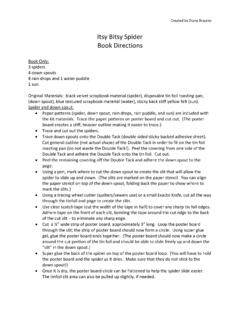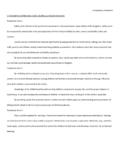Transcription of Effective Classroom Adaptations for Students with …
1 68 THECOUNCIL FOREXCEPTIONALCHILDRENTEACHING Exceptional Children, Vol. 33, No. 6, pp. 68-74. Copyright 2001 Classroom Adaptations for Students with Visual ImpairmentsPenny R. CoxMary K. Dykes Basic traffic safety Playground boundaries Cafeteria use Computer use in library or media cen-ter Readable maps and charts Verbal (auditory) alternatives Emergency proceduresHow does your school or classroommeasure up in these categories when itcomes to making Adaptations for youngpeople with visual impairments? Youneed to answer many questions: Caneverybody exit the building quickly inthe event of an emergency?
2 Can all stu-dents locate and use water fountains?How about items on bookshelves in theclassroom or library? Or special learningcenters in the Classroom ?We can appropriately teach studentswith visual impairments in general edu-cation settings. But we must be surethat we are informed about Students visual abilities and their affect on learn-ing and integration in the general class-room article discusses strategies forincluding Students with visual impair-ments into general education article provides a starting pointfrom which general educators can beginto learn about visual impairments andbuild skills that will benefit all their stu-dents (see box, Commonly UsedTerms ).
3 Categories of VisualImpairmentsCategories of visual impairments reflectmore than just visual acuity. Students ability to use vision, as well as howmuch they use other senses for learn-ing, are aspects of each category(Bishop, 1996; Turnbull, Turnbull,Shank, Smith, & Leal, 2002). The termslow vision, functionally blind, and blindare often used to describe and catego-rize levels of vision. Each category isconsidered in terms of the degree ofacuity and its implications for Students learning. Low , Students withlow vision are able to learn usingtheir visual sense; however, they mayneed to have print magnified, con-trast enhanced, or type font or sizechanged (Turnbull et al.)
4 , 2002). Students in this category characteris-tically work more slowly and experi-ence difficulty working with details(Colenbrander in Barraga & Erin,1992). Functional withfunctional blindness typically use acombination of modalities to functionwithin their surroundings (Turnbullet al., 2002). Students in this categorygenerally read and write using functionally blind individualshave sufficient vision to allow themto move around the Classroom , however, may require consid-erable accommodations to do so. blindness and totalblindness are included in this catego-ry.
5 Near blindness occurs when visu-al acuity is reduced so greatly thatlearning takes place using data fromother senses most of the time(Colenbrander in Barraga & Erin,1992). Students with total blindnessreceive no stimuli from their visualchannel. They depend entirely oninput from other senses. Incidental LearningStudents with visual impairments lackopportunities for incidental learningthat occur for their sighted peers almostconstantly (Hatlen & Curry, 1987).Without such opportunities, associatingwords with elements of the environ-ment is difficult.
6 Thus, it is importantthat such associations be supplementedwith input from other senses andthrough alternative limited nature of visual associa-tions for Students with visual impair-ments has Classroom of or reduced visual cues, suchas a schedule written on the chalkboardor seeing the clock, can prevent thesestudents from following Classroom pro-cedures or anticipating coming need opportunities to becomeacquainted with their Students with visual impair-ments may not readily associate namesand faces through incidental classroomexperiences, teachers need to designappropriate experiences to help buildrelationships among all Students in aclass.
7 Physical orientation of Students toclassroom routines or other events thattake place during the day is importantand must occur as soon as possibleonce the student is assigned to and MovementStudents with visual impairmentsshould move around the Classroom orother areas of the school just as theirsighted peers do. Free movementaround school is an essential part ofsuccessful school experiences. Orien-tation and mobility training helps stu-TEACHING EXCEPTIONALCHILDREN JULY/AUGUST2001 69dents accomplish this goal. Koenig(1996) stated that such training pro-motes safe, efficient, graceful, and inde-pendent movement through any envi-ronment, indoor and outdoor, familiarand unfamiliar (p.)
8 260). Orientationand mobility skills help people knowwhere they are in relation to their sur-roundings and how to safely navigatewithin their environment (Turnbull etal., 2002). Relevant skills for the school settinginclude knowing where landmarks arethroughout the school setting; beingfamiliar with the layout of classroomsand common areas such as the library,gym, and cafeteria; and knowing whereexits, restrooms, the main office, andother relevant areas are. Students needtraining in the school s emergency pro-cedures, such as fire, tornado, or earth-quake drills.
9 Orientation and mobilityskills are also important in outdoorareas such as playgrounds and bus load-ing zones (see Figure 1 on page 70 for achecklist of skills for Classroom teach-ers).Different types of mobility systemsare available, including sighted guides,canes, guide dogs, and electronicdevices (Hill & Snook-Hill, 1996).Orientation and mobility specialists canhelp determine the best system to usefor individual Students ; as well, the spe-cialists can provide information aboutthe preferred system and any traininggeneral education teachers may Effective LearningEnvironments ThroughCollaboration with VisionSpecialistsStudents with visual impairmentsplaced in general education classes usu-ally get support services from a visionspecialist (Heward, 2000).
10 Such topicsas learning through other senses,instructional and curricular Adaptations ,and appropriate resources and materialsare the domain of vision educators will find these col-leagues a valuable source of informa-tion and assistance that will help themcapitalize on Students abilities (seeFigure 2 on page 71 for a checklist ofclassroom materials and strategies forteachers).General education teachers servingstudents with visual impairments mustwork in collaboration with vision spe-cialists. Vision specialists should be apart of the team of professionals work-Most Students with visual impair-ments have some usable NEED TO DESIGNAPPROPRIATE EXPERIENCES TOHELP BUILD RELATIONSHIPSAMONG ALL Students IN A CLASS.







